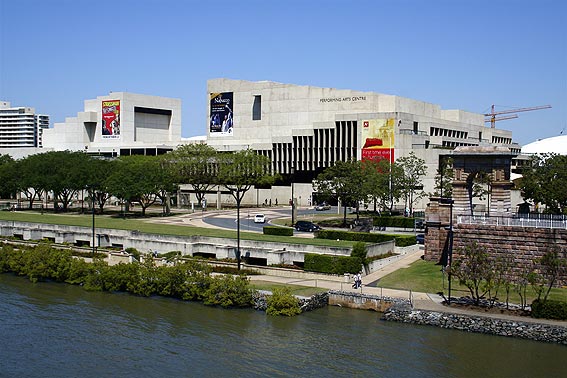
Queensland Performing Arts Centre
[Photograph by Trevor Bunning (October 2007)]

Queensland Performing Arts Centre
[Photograph by Trevor Bunning (October 2007)]
Historical and Technical Documentation by Geoffrey Cox
© OHTA 1989, 1998, 2007, 2011 (last updated May 2011)
The Queensland Performing Arts Centre (QPAC) is situated on the South Bank of the Brisbane River, linked by the Victoria Bridge to the Central Business District of Brisbane. The Cremorne Theatre, which opened in 1911, occupied the site on the corner of Melbourne Street and Stanley Quay until it was destroyed by fire in 1954.
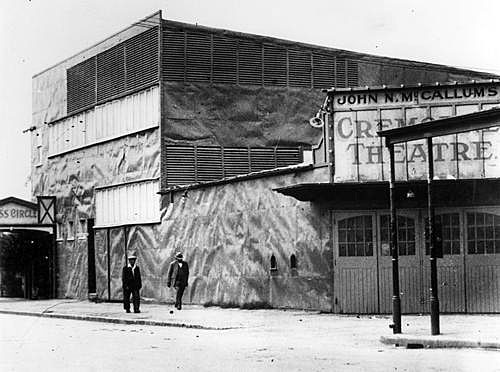
The Cremorne Theatre, South Brisbane, c.1934
[Photograph: John Oxley Library, State Library of Queensland]
The Brisbane City Council acquired the land in 1955, and it passed to the Queensland Government in 1966. From this time, the concept of a cultural centre began to emerge, and Brisbane architect Robin Gibson was commissioned for the task. Preliminary work began on the site in 1976 and the Queensland Art Gallery was opened in 1982. The Queensland Performing Arts Centre was officially opened by His Royal Highness the Duke of Kent on 20 April 1985, and the Queensland Museum was opened in 1986. The State Library was completed in 1988, and the Playhouse Theatre was opened in September 1998, completing Robin Gibson's original plan.1
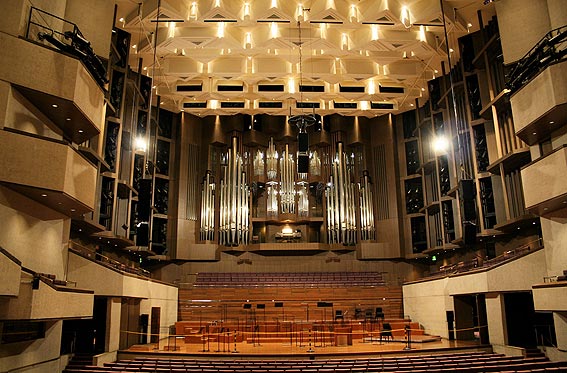
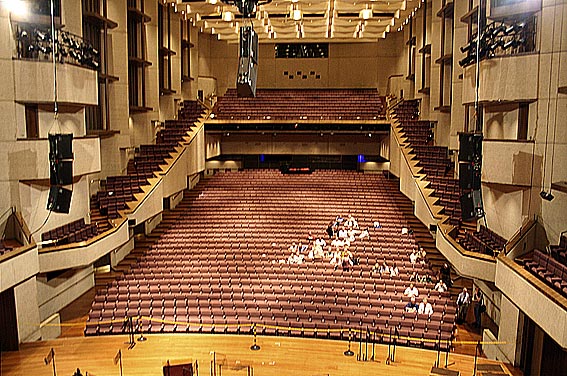
The interior of the Concert Hall
[Photographs by Trevor Bunning (October 2007)]
The organ in the Concert Hall was built in 1985-86 by Johannes Klais Orgelbau of Bonn, W. Germany.2 Although the company has had considerable experience in building large organs for new concert halls in Munich, Cologne and elsewhere,3 this is the first instrument they have built for Australia. Robert Boughen acted as honorary organ consultant.
Voicing of the organ was completed in January 1987 and an inaugural season of recitals was held in May that year.4 A second Principal 8 was added by Klais to the Great in 1988.5
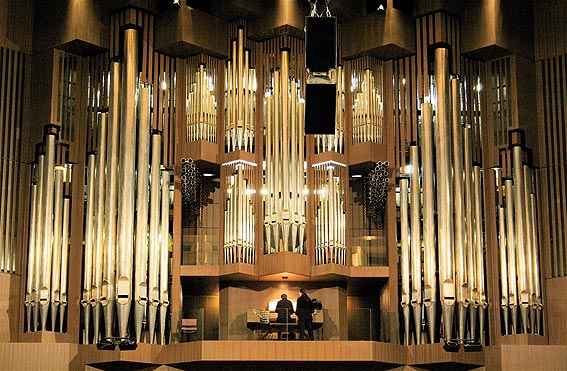
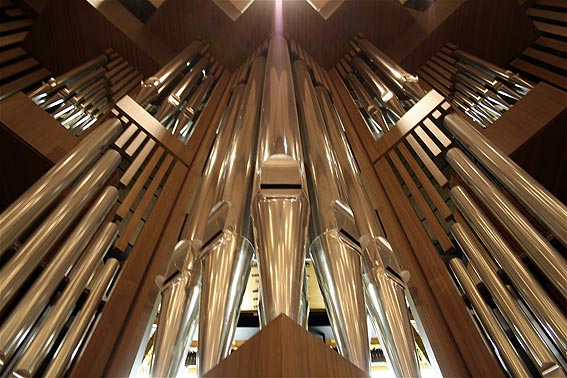
[Photographs by Trevor Bunning (October 2007)]
| GREAT Praestant1 Rohrgedackt Principal I-II Doppelflöte Gemshorn Nasard Octave Nachthorn Terz Quinte Superoctave Mixtur Acuta Cornet1 Trompete Trompette 1 Trompete 1 Clairon 1 Glockenspiel1 |
116 16 8 8 8 5-1/3 4 4 3-1/5 2-2/3 2 VI IV 1V 16 18 18 14 12 |
façade from C to cs3 hammered, domed caps with chimneys open, with 2 opposite mouths stringy cylindrical 2, 1-1/3, 1-1/3, 1, 2/3, 1/2 1, 2/3, 1/2, 1/3 from a0, mounted hammered, 8, 4, 2-2/3, 2, 1-3/5 Schnitger, with wide shallots, brass plated Clicquot, french blocks, from fs3 2 rks. flues Schnitger, from fs3 2 rks. flues Clicquot, french blocks, from fs2 3 rks. flues c1-f3 |
| SWELL (enclosed) Bourdon Geigenprincipal Flûte harm. Metallgedackt Spitzgamba Unda maris 1 Fugara Flûte octaviante Octavin Plein jeu Basson 1 Trompette harm. 1 Hautbois 1 Clairon harm. 1 |
16 8 8 8 8 18 4 4 2 VI 116 18 18 14 |
overblowing from fs hammered, domed caps wide from c0, flute-like, low beating overblowing from fs overblowing 2-2/3, 2, 2, 1-1/3, 1, 2/3 C-H 8'-length, French blocks from c1 french blocks from c0, from fs3 2 rks. flues french, from c0, from fs3 2 rks. flues french blocks from fs2 3 rks. flues |
| POSITIV Pommer Praestant 1 Holzgedackt Quintade Bifaria1 Principal Rohrflöte Octave Waldflote Larigot Sesquialter Scharff Cymbel Dulcian Solotrompete1 Cromorne 1 |
16 18 8 8 18 4 4 2 2 1-1/3 II V III 16 18 18 |
hammered façade from C to a0 domed caps from c0, low-beating, principal-style hammered, domed caps with chimneys 2-2/3, 1-3/5 1-1/3, 1, 2/3, 1/2, 1/3 1/2, 1/3, 1/4 Renaissance style soloistic, yet blending, from fs3 2 rks. flues french form, baroque, from fs3 2 rks. flues |
| SOLO (enclosed) Salicional Rohrflöte Gamba Fernflöte Vox coelestis1 Blockflöte Salicet Nasard Flageolett Terz Sifflet Harm. aetheria Clarinette1 Schalmey 1 Vox humana 1 |
16 8 8 8 18 4 4 2-2/3 2 1-3/5 1 III 18 18 18 |
C-H stopped, offset from chest domed caps with chimneys S-beards from c0, beating higher, with expression 2-2/3, 2, 1-3/5 english, from fs3 2rks. flues from fs3 2rks. flues Typ Cavaillé-Coll from fs3 2rks. flues |
| TROMPETERIA Tromp. magna Tromp. de bat. Orlos Bajoncillo |
16 8 8 4 |
(with possible coupling to Solo, Great, Pedal) chamade chamade chamade chamade |
| PEDAL Praestant1 Untersatz Principal Subbass Contrabass Octave Trichtergedackt Cello Superoctave Koppelflöte Jubalflöte Hintersatz Pedalmixtur Aliquot Contraposaune Bombarde Posaune Trompette Holztrompete Schalmey |
132 32 16 16 16 8 8 8 4 4 2 V IV IV 32 16 16 8 8 4 |
façade from E to f0 façade from C to A open from C hammered domed caps, funnel-shap. with cyl. tops with two mouths 4, 2-2/3, 2, 1-1/3, 1 2, 1-1/3, 1, 2/3 5-1/3, 3-1/5, 2-2/7, 2 16'-length Clicquot soloistic soloistic |
| COUPLERS Positiv to Great Swell to Great Solo to Great Swell to Positiv Solo to Positiv Solo to Swell Trompeteria to Great Trompeteria to Solo Trompeteria to Pedal Positiv to Pedal Great to Pedal Swell to Pedal Solo to Pedal |
with optional mechanical coupling with optional mechanical coupling with optional mechanical coupling mechanical |
|
| Cymbelstern 7 bells, cs2, e2, a2, cs3, e3, a3, c'''' Nachtigall with 2 pipes, g3 + c'''' [above two have draw stops, not for use with setter combination] |
||
| Swell tremolo Positiv tremolo Solo tremolo Pedal-solo tremolo 8 pistons/toe studs for Solo, Swell, Great, Positiv, Pedal 8 general combinations A-H 40 [memory levels] crescendo roll with indicator and on/off pedal switch balanced swell & solo pedals with indicators tutti toe stud general cancel piston setter piston compass: 61/32 mechanical key action electric stop action 2 pedalboards (German radiating concave & German flat straight) adjustable organ bench attached Cavaillé-Coll style console.6 |
||
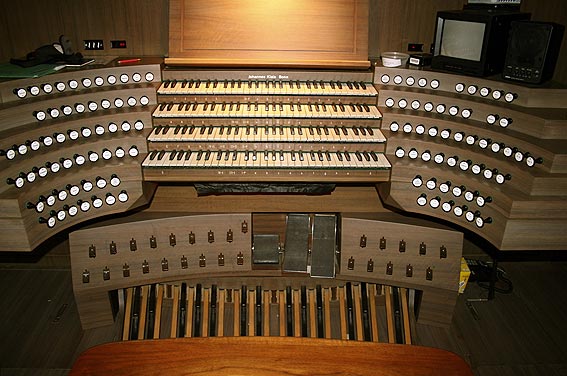
The Cavaillé-Coll style console,
with the optional straight pedalboard
[Photograph by Trevor Bunning (October 2007)]
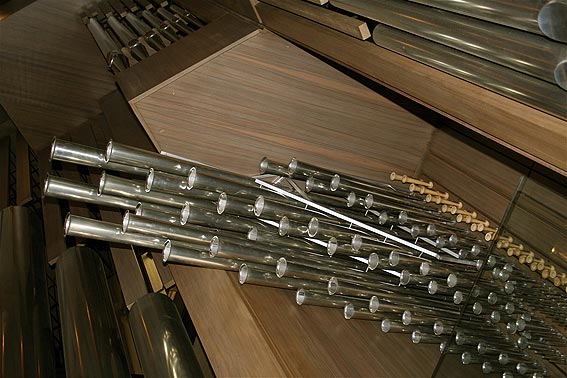
Horizontal (en chamade) pipes of the Trompeteria
[Photograph by Trevor Bunning (October 2007)]
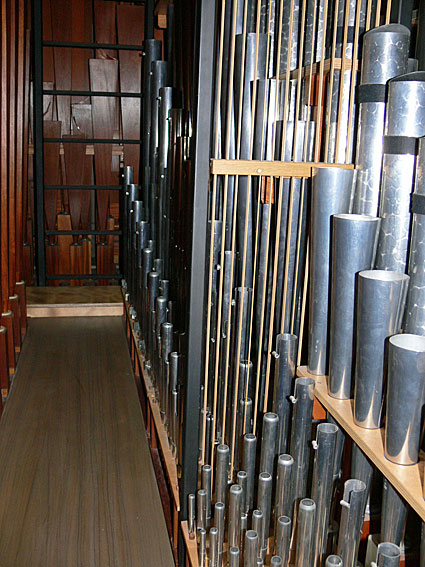
Pipework of the Pedal Organ
[Photograph by John Maidment (October 2007)]
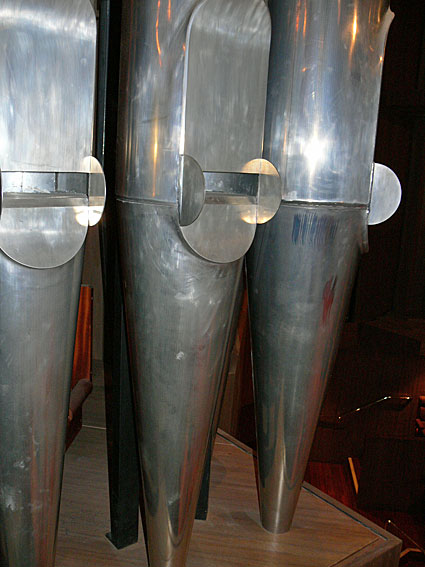
Façade pipes of the Praestant 32ft on the Pedal Organ
[Photograph by John Maidment (October 2007)]
______________________________________________________________________________
1 'QPAC History', from http://www.qpac.com.au - accessed 5 July 2007, and 25 May 2011.
2 Sydney Organ Journal, vol. 16, no. 5 (Oct/Nov 1985), pp. 37-40; The Sunday Mail Color Supplement (20 July 1986), pp. 4-5.
3 Hans Gerd Klais, 'Organs for Concert Halls: Thoughts and Experiences,' Organists' Review, vol. 72, no. 285 (February 1987), pp. 33-42.
4 The Courier-Mail (22 January 1987), p. 24; (5 May 1987), p. 32; (9 May 1987), p. 12.
5 Personal communication to G. Cox from Simon Pierce, 1988.
6 Specification from The Concert Hall Organ (Brochure, Performing Arts Complex, c.1987).